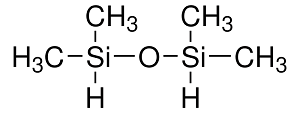1,1,3,3-Tetramethyldisiloxane

Product Description
1,1,3,3-Tetramethyldisiloxane, also known as TMDSO, is a versatile organosilicon compound with various industrial applications.
Product:
1,1,3,3-Tetramethyldisiloxane
CAS:
3277-26-7
Synonym:
1,3-dihydrotetramethyldisiloxane; sym-tetramethyldisiloxane; Bis(dimethylsilyl)ether; Bis(dimethylsilyl)oxide; Tetramethyldisiloxane
Structure:

Typical Characteristics
Appearance
Colorless liquid
Boiling point
70-71 °C
Density
0.76 g/cm3
Melting point
<-78 °C
Molecular Weight
134.32
Purity
97%
Refractive index
1.370
Uses, Applications & Markets
Key applications
get a quote
We Offer 1,1,3,3-Tetramethyldisiloxane
in various grades
A few of the grades available are listed below:



1,1,3,3-Tetramethyldisiloxane used in many
industry applications
1,1,3,3-Tetramethyldisiloxane, also known as TMDSO, is a versatile organosilicon compound with various industrial applications. Here are some of its uses:
- Silicone Synthesis: 1,1,3,3-Tetramethyldisiloxane serves as a precursor in the synthesis of silicone polymers and resins. It undergoes hydrolysis and condensation reactions to form linear or cross-linked silicone chains. These silicones are used in sealants, adhesives, coatings, elastomers, and mold-making compounds in construction, automotive, electronics, and consumer goods industries.
- Surface Modification: 1,1,3,3-Tetramethyldisiloxane is used as a surface modifier or release agent in various applications. It can be applied to metal, glass, plastic, and ceramic surfaces to impart water repellency, lubrication, and anti-stick properties. TMDSO-based coatings are used in cookware, bakeware, textiles, electronic components, and optical lenses to reduce friction and prevent adhesion.
- Chemical Vapor Deposition (CVD): 1,1,3,3-Tetramethyldisiloxane is employed as a precursor in the CVD process for depositing silicon dioxide (SiO2) or silicon carbonitride (SiCN) thin films on substrates. It is vaporized and decomposed in a heated chamber to produce silicon-containing coatings with controlled thickness, composition, and properties. These coatings are used in semiconductor manufacturing, optical coatings, and protective layers on electronic devices.
- Organic Synthesis: 1,1,3,3-Tetramethyldisiloxane is used as a reagent or solvent in various organic synthesis reactions. It can act as a reducing agent, protecting group, or nucleophilic source of silicon atoms in chemical transformations. TMDSO is employed in the synthesis of pharmaceutical intermediates, agrochemicals, specialty chemicals, and functional materials.
- Hydrophobic Coatings: 1,1,3,3-Tetramethyldisiloxane is utilized in the formulation of hydrophobic coatings for building materials, textiles, and consumer products. It imparts water repellency and stain resistance to surfaces by forming a durable and invisible barrier against moisture and contaminants. TMDSO-based coatings are applied to concrete, stone, fabric, leather, and paper substrates to protect them from water damage and soiling.
- Gas Chromatography: 1,1,3,3-Tetramethyldisiloxane is used as a derivatization reagent in gas chromatography (GC) analysis of polar or acidic compounds. It reacts with functional groups such as hydroxyl, carboxyl, or amino groups to form trimethylsilyl (TMS) derivatives, which are more volatile and less polar than the original analytes. TMDSO derivatives improve the chromatographic separation and detection sensitivity of organic compounds.
- Silicon-Based Materials: 1,1,3,3-Tetramethyldisiloxane is employed in the synthesis of silicon-based materials such as silicon carbide (SiC), silicon nitride (Si3N4), and silicon oxynitride (SiON). It serves as a silicon precursor in the sol-gel process or chemical vapor deposition (CVD) method for producing ceramics, composites, coatings, and advanced materials with tailored properties for aerospace, automotive, and electronic applications.
- Photoresist Stripping: 1,1,3,3-Tetramethyldisiloxane is used in semiconductor manufacturing for photoresist stripping and residue removal after lithography processes. It effectively dissolves and removes photoresist films, polymer residues, and organic contaminants from silicon wafers without damaging the underlying substrates or circuitry. TMDSO-based stripping solutions are used in integrated circuit fabrication and microelectronics production.